VOL.52, NO. 4
Finding the Queer Shakespeare Film
Curtis Dunn
Defining the Queer Shakespeare Film
Shakespeare’s plays have been adapted into a variety of film genres: from 10 Things I Hate About You (Junger 1999) and She’s the Man (Fickman 2004) appropriating Shakespearean comedies into teen romantic comedies to crime thrillers Maqbool (Bhardwaj 2003), Macbeth (Wright 2006), and Cymbeline (Almereyda 2014), retelling Shakespeare’s dramas using generic gangster signifiers. West Side Story (Wise and Robbins 1961) adapts one of the most enduring romances ever written, Romeo and Juliet, into one of the most enduring movie musicals ever made. Even a tertiary survey yields countless transmediations of Shakespeare across a vast array of film genres. One might assume that after the proliferation of queer cinema in the late twentieth century, a number of queer Shakespeare adaptations would also materialize; after all, Shakespeare’s plays have been the source of inspiration for filmmakers ever since the medium first gained prominence. Even with Shakespeare being the most frequently adapted author in the English language (IMDb lists over 1,800 credits) and queer cinema having a foothold as a distinct and legitimate film genre, surprisingly few films can be considered both queer and Shakespearean.
Does this limited selection of adaptations and appropriations of his works on film, all with uneven levels quality and sustained engagement with queerness, point toward a strained relationship between LGBT artists and the Bard? In an episode aptly titled “ShakesQueer,” the contestants of RuPaul’s Drag Race fail miserably at parodying Shakespeare to the point the host, RuPaul Charles, claims that in seven seasons he has “never seen a car crash like [it] before” and proceeds to mock shooting himself in the head. Some admit their unfamiliarity with Shakespeare (“I don’t even know what Macbeth is”) while others stumble over iambic pentameter. Shakespearean parody, which shares a similar ancestor to “glamour drag” in the form of Victorian variety entertainment (Senelick 83-84), has not been attempted on the show since. By opening with this episode, I want to elucidate one way LGBT culture (and one of the most prolific of its cultural outputs) has recently interacted with Shakespeare. This is not to say that all queer people are unfamiliar with Shakespeare, but it illustrates a lack of general engagement with his works within the “the indigenous queer performance form” of drag (Jeffreys)—and perhaps the queer community more broadly. Queer people, as a historically persecuted minority group, could look toward the way Shakespeare has been used by colonial cultures to “reassert the value of their own pre-existing traditions and practices” (Dionne and Kapadia 3). Queer artists have the opportunity to stake their claim in Shakespeare, but perhaps their most powerful ally, queer cinema, has only limitedly engaged with his works. Further, few of the films that can be considered both queer and Shakespearean particularly succeed at being both things at once—and there is little interrogation of this in Shakespeare or film studies.
The question becomes, then: what makes a film adaptation of Shakespeare queer? “Adaptation” and “queer” are thorny words. In defining “adaptation,” I will be following Geoffrey Wagner’s taxonomy that identifies three categories of the practice: transposition, commentary, and analogy (Wagner 222-31; McFarlane 10-11). The latter two might technically fall under Julie Sanders’s definition of “appropriation” (34), but I will, like Wagner, almost exclusively use the term “adaptation.” I am looking primarily for commentaries—wherein “an original is taken and either purposely or inadvertently altered in some respect” (Wagner 223)—since more direct transpositions will mostly neglect queer audiences given the general lack of explicit LGBT+ characters and content in the original Shakespearean text, while analogies run the risk of eschewing the source text so far that it is no longer immediately recognizable as an adaptation of Shakespeare (as will be explored later.) “Queer,” similarly, raises semantic difficulties. Its definition within queer theory, “broadly understood as that which is at odds with what has been deemed to be the normal, the legitimate and the dominant” (Patricia xxii), is useful to keep in mind, as queer cinema has historically (and definitionally) been made up of films that subvert heteronormativity. While inflected by this definition, I am generally using the term in the modern, colloquial sense—essentially as a synonym for “LGBT+.” The definitional boundaries between queer as identarian signifier (roughly synonymous with LGBT+) and theoretical designation (that which is opposed to heteronormativity) are slippery. I will use queer interchangeably with other signifiers like LGBT and become more specific when discussing different subcommunities within the larger queer umbrella; but to identify what is, definitionally, a “queer Shakespeare film,” one must consider what constitutes a queer film to begin with.
Harry M. Benshoff and Sean Griffin posit that one way a film can be queer is if it “both contains queer characters and engages with queer issues in some meaningful—as opposed to derogatory or exploitative—way” (10). They go on to explain that films can also be considered queer by authorship, by spectatorship, generically, or experientially (10-11). All of these latter frameworks, while discursively useful when approaching film criticism through a queer lens, fall short of being recognizably queer. For example, to the average viewer, Franco Zeffirelli’s Romeo and Juliet (1968) is a very heteronormative film—after all, its source text may be the most recognizable heterosexual romance in all of English literature. Knowing Zeffirelli’s sexuality, and therefore approaching the film’s queerness based on authorship, may influence our perception of it as queer, but it requires a meticulous dissection of the semiotics of the film to come to this conclusion.1 Anything a queer person watches, according to the spectatorship framework, could be argued as queer. Generic frameworks (essentially, all musicals are queer) or experiential frameworks (the act of viewing a film is inherently queer) are even flimsier still. For the purposes of finding recognizably queer adaptations of Shakespeare, I will use Benshoff and Griffin’s first suggestion. A queer Shakespeare film should feature queer characters and meaningfully engage with queer issues but be adapted from a Shakespearean source text. While I considered over a dozen works that fall under this preferred definition, I necessarily had to limit the scope of this study. Films not in the English language, such as Eytan Fox’s The Bubble (2006); art, ultra-low budget, and/or student films, like Celestino Coronado’s Hamlet (1976); and filmed versions of theatrical performances were not considered.
In one of the only extended analyses of queerness in Shakespearean cinema—Anthony Guy Patricia’s Queering the Shakespeare Film—the author attempts to “queer” film adaptations of Shakespeare, fitting his work into the critical movement, as typified by Menon Madhavi’s ShakesQueer, that applies principles of queer theory to Shakespearean texts. His book and most of the limited number of other works on the subject (which he helpfully identifies in his introduction) seek to do the same to the cinematic texts of film adaptations of Shakespeare. As such, they only limitedly engage with questions surrounding the transposition of Shakespeare into contexts related to the LGBT+ community. Despite deeply compelling arguments for each, of the ten films Patricia analyzes only one, Alan Brown’s Private Romeo (2011), could be said to explicitly deal with queer characters and relevant social issues, while the rest are considered queer by way of authorship and, most prominently, spectatorship (using queer theory or employing what he and others call the “gay male gaze.”)
Utilizing queer theory and a queer gaze can prove very productive in shedding light on subtle, subtextual, or even subconscious queerness in otherwise ostensibly heteronormative texts, but its taxonomical utility is limited because of its broad definition of what “queer” is (essentially, that which is oppositional to heteronormativity.) Queer theory can be provocative and fruitful in its remit, but it is less utile for analyzing artistic contributions to the pursuit of greater visibility for LGBT people in popular media because its definitional boundaries are inherently too expansive and somewhat fuzzy around the edges. I would not consider Zeffirelli’s Romeo and Juliet a queer Shakespeare film, but I do agree with Patricia when he argues that queerness abounds within its cinematic text. Benshoff and Griffin dismiss this “connotative homosexuality” as falling short of making a film distinctly, or at least explicitly, queer (10). Vito Russo’s seminal survey of gay visibility in American cinema, The Celluloid Closet, traces this connotative queerness throughout the artform’s history, but most of Russo’s manifold examples of queerness in pre-New Queer Cinema films fall short of our relatively low threshold of a queer film needing to have both queer characters and also an engagement with queer culture or issues in a meaningful way. Queer films have proliferated in the era following The Celluloid Closet and New Queer Cinema, but queer Shakespeare adaptations remain scarce—and those that exist mostly fall disappointingly short of being considered successful queer films.
To produce an adaptation of Shakespeare that appeals to a queer audience, filmmakers could consider concepts of indigenization in adaptations of Shakespeare in languages other than English. Much has been written about how transcultural adaptations successfully incorporate aspects of the adapting culture into Shakespeare (and vice versa.) Perhaps the best examples of this practice are in Akira Kurosawa’s adaptations, including Ran (1985). This adaptation of King Lear, as Jessica Chiba argues, transforms Shakespeare’s play into “an indigenous cinematic work of art for a Japanese audience” (602). While Chiba uses Ran to explore the problems inherent in translating Shakespeare, her analysis of the film as “bent on localizing a text by embedding it in sixteenth-century sengoku culture” is of particular interest (606). What I am proposing is that, considering people within the queer community have developed their own culture that is distinct from the historically dominant heteronormative one, “localization” could be identified in queer film adaptations of Shakespeare and should be explored further. While the level of success in indigenization can always be debated, my search is for film adaptations that utilize Shakespeare as a canonical text to comment on matters relevant to a queer audience, as Chiba argues Ran does for a Japanese one (618). In another example, Craig Dionne and Parmita Kapadia claim Vishal Bhardwaj’s Maqbool (2004) “is a powerful example of a local appropriation that troubles the simple binary that Shakespeare must always represent a univocal Western tradition” (5). I am seeking, then, to identify examples of films that powerfully trouble the binary that Shakespeare must represent a univocal straight tradition.
The Canon
In 2017, Anthony Guy Patricia identified just twenty titles within Shakespeare scholarship that specifically engage with queer Shakespeare films, and over half of those only deal with three: Derek Jarman’s The Tempest (1979), Gus Van Sant’s My Own Private Idaho (1991), and Richard Loncraine’s Richard III (1995) (xxi). It is not a reach, then, to claim that these three films make up the core of the queer Shakespeare film canon; yet all three are deeply flawed in the way they engage with queerness and, more specifically, the LGBT community. While they feature ostensibly gay (male) characters, they do not reflect queer society or issues that are relevant to the queer people they are meant to represent.
Perhaps the most discussed Shakespeare film in the queer canon is Jarman’s The Tempest. Kate Chedgzoy contends that the film has “been judged by most of its critics to be an extremely queer film” (193). Its filmmaking techniques can read as queer—extended sequences of male nudity exemplify the “homosexual gaze” William Van Watson defines in his conversation of queerness in Zeffirelli’s films (314-23)—but Jarman’s film lacks a consistent and explicit engagement with the queer community and its characters are hardly explicitly queer. Caliban, Prospero’s slave who is native to the island, and Ariel, Prospero’s fairy henchman, can both be read as queer-coded, but their queerness is far from unequivocal. Some critics claim that Jarman foregrounds “the same-sex relationship between Prospero and Ariel” (Harris and Jackson 90) or that Caliban and Ariel can, as Cornelis Martin Renes argues, “be understood to represent antagonizing tendencies of . . . hetero- and homosexuality in Prospero” (228). In such a Jungian reading, the film “becomes a pamphlet against the repression of homoerotic desire, visually describing the act of coming out of the closet as Ariel’s leaving the mansion” with Jarman inviting “the viewer to revel in the homosexual universe” (231). These writers all argue their points cogently, but their arguments center around the cinematic text being implicitly about homosexuality—in fact, there is no explicit confirmation of any of these characters’ sexualities. Caliban is played by Jack Birkett, described by one critic as a “gay icon” (227), but even if he is portrayed as “camp” and “hardly a sexual threat to Miranda” (Harris and Jackson 93), there is little explicit sexuality afforded the character. Diana Harris and MacDonald Jackson similarly find Ariel coded as queer, pointing to the pearl on his left ear and claiming that “he comes across as knowingly and securely gay” (see Figure 1). The audience can read these characters as queer only if they take the extra step of interpreting their camp physicality or the type of jewelry they wear as signifiers of their sexuality.
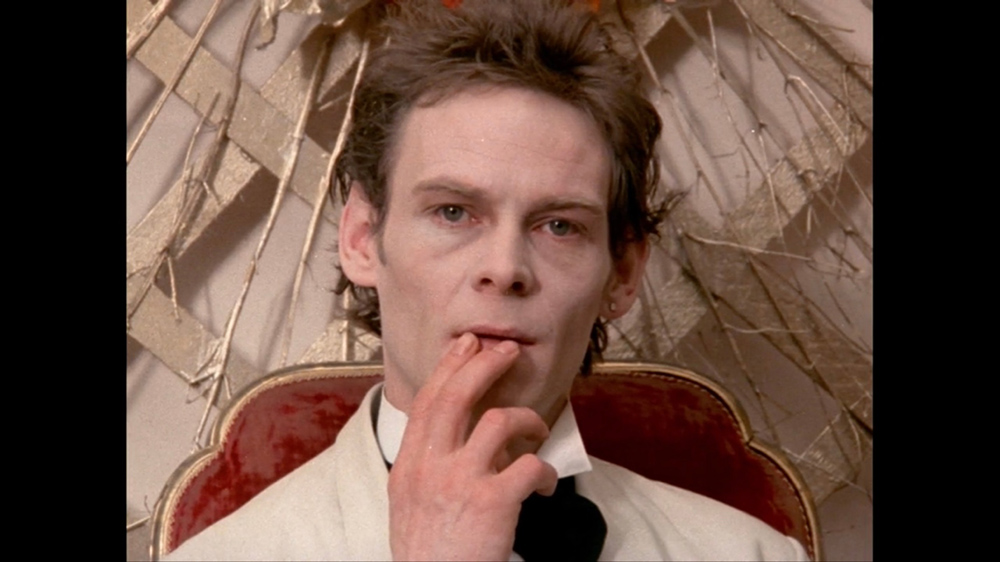
Both characters’ actions rarely confer an explicit homosexuality. Harris and Jackson highlight the wedding masque and Elisabeth Welch’s rendition of “Stormy Weather,” sorting through the reactions to the performance by the various characters assembled for the finale. On the line “Since my man and I ain’t together / Keeps rainin’ all the time,” we see a “touching close-up” showing “a sad and pensive Ariel, forefinger brushing his lips” (96). Should the audience immediately recognize this as confirmation of Ariel’s desire for Prospero and therefore his queerness? Overall, it requires too much semiotic analysis—a homosexual gaze—to find the queerness in these characters, and thus cannot easily slot into our framework of having explicitly queer characters. Even if we can accept Caliban and Ariel—and perhaps Prospero—as queer characters, there is little engagement with any queer issues, except those which are implicit and require dissection and an existing understanding of Jarman’s own sexuality and radical politics. Welch singing “Stormy Weather” surrounded by very handsome dancing sailors is, naturally, a very queer way to end the film, but Jarman’s adaptation of the play is not actually very radical in its queerness. Chedgzoy argues that the “camp glory” of Welch’s performance “does nothing to enhance the appeal of institutionalised heterosexuality,” reified by the wedding at the center of the scene (204). In the end, heteronormativity, while briefly shaken up throughout the film, returns in the form of the heterosexual marriage of Miranda and Ferdinand. This march toward heteronormativity, I will continue to argue, limits the success of most queer adaptations of Shakespeare, and I agree with Chedgzoy that no matter how aesthetically queer Jarman’s ending is, it falls well short of queering its source’s innate heteronormativity and thus fails to fully indigenize Shakespeare for a queer audience.
Similarly, Loncraine’s Richard III may feature a wonderfully camp performance from Ian McKellen that some critics rightly read as queer-coded, but its 1930s setting and particular interest in fascism move it far away from any useful commentary on the state of being a queer person in 1995.2 Michael D. Friedman goes as far as to argue that, even though McKellen was a vocal supporter of gay causes at the time, his screenplay (co-written with Loncraine) “plays into a stream of homophobia . . . which casts homosexuals as murderers for their role in the AIDS crisis” including portraying “Richard as a man with homosexual tendencies who derives perverse erotic pleasure from causing the death of others” (574). Citing the decision to set the murder of Clarence in a location suggestive of a bathhouse (see Figure 2), conjuring up “associations with promiscuous homosexual activity” and thus HIV, Friedman argues that the “juxtaposition of Richard’s homiciphilia [sexual pleasure derived from homicide] with McKellen’s homosexuality acquires a sinister connotation that leaves the film susceptible to a homophobic interpretation” (573-74). This ambivalence—or even antipathy—toward homosexuality immediately problematizes any claim of the film being a successful queer adaptation. This is further reinforced by another return to heteronormativity: “To gratify his primarily heterosexual audience, McKellen kills off his homosexual protagonist and allows a ‘normal’ straight couple to regain control of England” (569). Of course, this is not a deviation from the Shakespearean source material (except in that the audience gets to see the wedding ceremony—see Figure 3), but the additional layer of Richard’s implied homosexuality does little to refute its inherent heteronormativity—just as the implicit sexualities of Jarman’s characters do not negate the film’s heteronormative conclusion. All queer adaptations of Shakespeare, or even particularly queer-minded productions of his plays, will be constrained by an inescapable heteronormativity rooted in an early modern ethos.
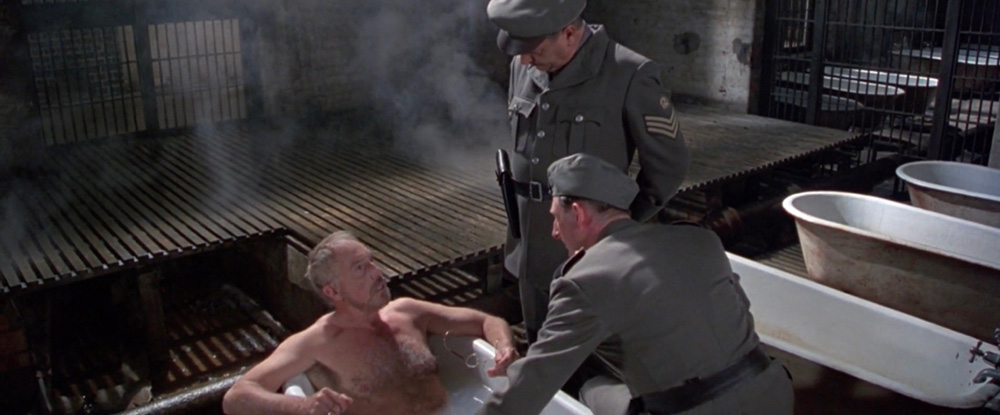
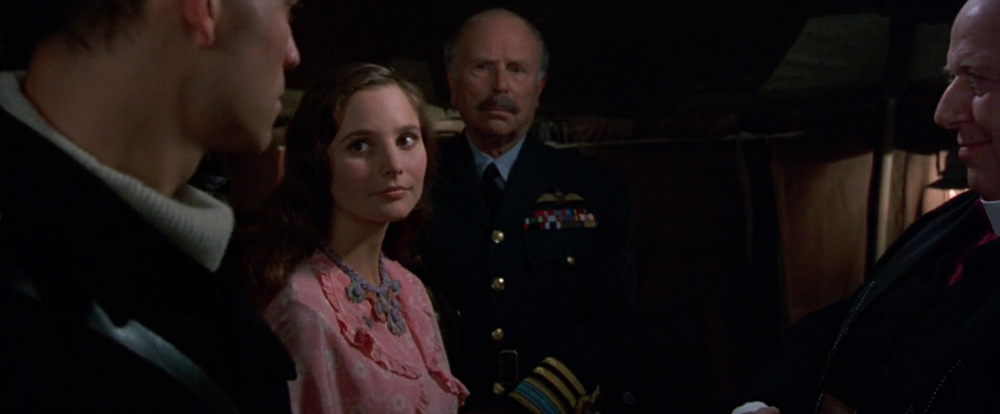
Alan Sinfield’s cultural materialist analysis of Antonio in Merchant of Venice, one of the most explicitly queer characters in the canon (if one allows for such retrospective, even anachronistic, identarian designations,) does not take such heteronormative constraints as the end of queer possibility. Despite the play’s performance history that suggests mostly the opposite, Sinfield claims that Antonio does not need to appear “as the defeated and melancholy outside that critics have supposed” but instead interested parties can read “only partly against the grain” to achieve a joyful (and queer) resolution for the normally tragic gay stereotype that Antonio represents (66). This supposition is supported by other contenders for the title of queer Shakespeare film explored later in this article, but Loncraine’s film does not attempt such narrative subversion of the heteronormative underpinnings of its source text; instead, it raises more ethical questions about its use of queerness by encoding one of Shakespeare’s most iconic villains as the sole queer character in the film. A gay Richard is not incompatible with a successful queer film adaptation of Richard III because, after all, queer characters are allowed to be unlikeable—or downright villainous, as exemplified by McKellen’s performance—and varied portrayals are surely preferred over the pigeonholing and stereotyping chronicled in Vito Russo’s work, but as it is framed in Loncraine’s film, the semiotic implications of evoking the AIDS epidemic could be argued to be homophobic—regardless of whether one of its screenwriters/star actors is an outspoken advocate on gay issues. Even if McKellen’s performance as Richard raised no red flags in regards to its perpetuation of the “monstrous homosexual” trope identified by Russo, Friedman’s critique of the film’s return to heteronormativity is just as disqualifying from its claim to being a queer Shakespeare adaptation.
This same return to the heteronormative was perhaps inevitable for Van Sant’s My Own Private Idaho then. Godfrey Cheshire wonders: “How can a film which repeatedly puts its two stars into situations involving gay sex, a film by a director described by the press as ‘openly gay,’ not be about homosexuality?” While of the three films Idaho is the most explicit in its prominent featuring of queer characters, by following the arc of Shakespeare’s Henry IV plays, Van Sant’s analogue for Prince Hal winds up accepting his fate of marriage (and therefore heteronormativity) and his role as successor to his powerful father. Van Sant’s deviation from the norm of films about gay men up to that point, namely that they had to be tragic and about violence/disease, is commendable; however, he forgoes exploring the reality of life for male prostitutes in the early 1990s, including the lack of any mention of disease—once again actively eschewing any relevant commentary on the queer culture surrounding its ostensibly queer setting and characters. I agree with Cheshire’s conclusion that Idaho comments on homosexuality, but “the indirect message is troublesome” and by foregoing sustained queerness, Van Sant simply returns “the film to safe, gorgeous superficiality” (see Figure 4). It creeps closer to being a successful queer Shakespeare film, but lacks much of any engagement with queer culture or issues and its conclusion reifies the trope of homosexual dalliances making way for heteronormativity.
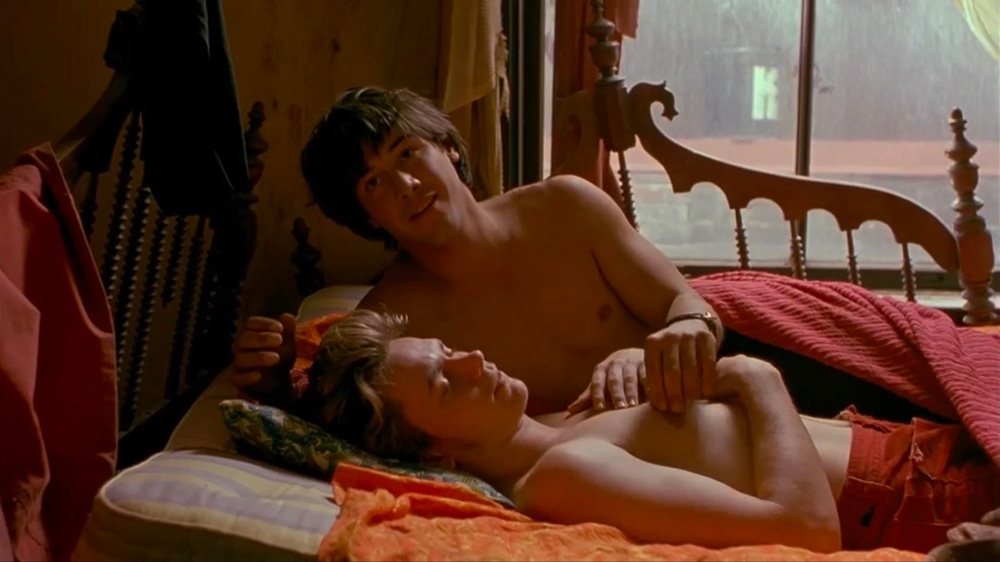
The Contenders
Two American films of the twenty-first century are notably more successful in featuring queer characters while also exploring issues relevant to a queer audience. The first, Tom Gustafson’s Were the World Mine, was released in 2008, when only three U.S. states had passed same-sex marriage laws—and still seven years before a supreme court decision legalized the practice across the country. Gustafson uses A Midsummer Night’s Dream to explore themes of homophobia that were very relevant to queer audiences of the time, even if they now may be considered somewhat trite (along with other tropes in queer cinema, such as coming out and HIV/AIDS narratives.) The film follows Timothy, an openly gay high school student, who is infatuated with his presumably straight classmate, Jonathon. When the former is cast as Puck in a musical production of Midsummer, he takes inspiration from the play’s love-in-idleness flower to create his own love potion that wreaks queer havoc on his all-boys’ school and fulfils his fantasy of being with Jonathon (see Figure 5). This sets up the film as an “analogy” according to Wagner’s taxonomy, meaning it is not so much a queer Shakespeare adaptation as it is a queer film that is inspired by Shakespeare. Ideally, a queer Shakespeare adaptation should be recognizable as directly adapted from the source text, but that should not negate the film’s merit in this discussion, as many plot points from Midsummer are recreated, if significantly skewed, in it.
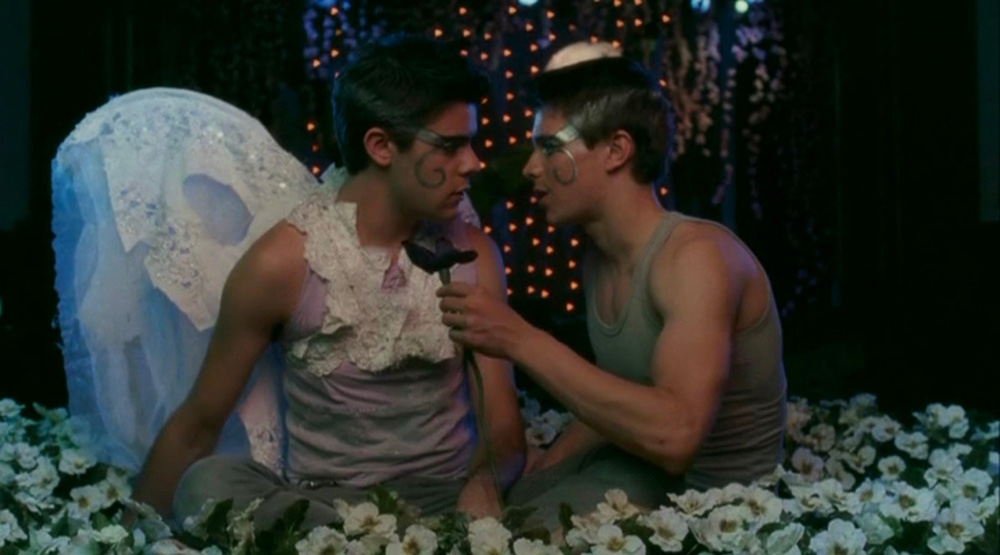
Were the World Mine features multiple queer characters and explores issues relevant to an LGBT+ audience. In David M. Halperin’s analysis of gay male culture, How to Be Gay, he alleges that a key aspect of growing up and realizing one’s homosexuality coincides with the realization that most love-objects are “categorically off-limits to them”:
Early on in our lives, at whatever point we become urgently aware of our desires, gay men discover that most of the human beings who attract us are not the least bit interested in having a sexual relationship with us, that they are not and cannot be attracted to us in return, and that some of them regard the mere fact of our desire for them as abhorrent. . . . [Our desire is] necessarily confined in the first instance to fantasizing about them. (229)
Gustafson’s use of Midsummer is in direct conversation with Halperin’s assertion. Unlike the three films in the core queer Shakespeare canon, Gustafson uses Shakespeare’s source text to explicitly explore a very real issue to young queer people: desiring love-objects who are categorically off-limits to them. Within minutes of the film’s opening, we are transported to our protagonist’s fantasy of Jonathon, the kind but forbidden jock, extending a hand to him, shirt unbuttoned, singing, “O, Timothy” (see Figure 6). Past the more obvious queer issues commented upon in the film (Timothy is called a host of slurs throughout,) Gustafson is using his film to speak to a queer sensibility, one in which a young gay man desires, is forbidden to desire, and ultimately resorts to fantasy. Helena, in Shakespeare’s original, also desires a man who does not reciprocate her feelings, but instead finds her romantic fantasies fulfilled through the employment of magic. Halperin points out that most people, regardless of their sexuality, have “at one time or another felt that many of the glamorous people they desired were beyond them, unavailable to them, and even possibly repelled by them” (just as Demetrius is of Helena,) but what Helena does not experience is her love-object being “categorically off-limits to [her], on account of [her] belonging to the wrong sex, which is what gay men experience” (229). Gustafson is using a plot point of Midsummer—the use of magic to resolve unrequited love—and indigenizing it to queer culture.
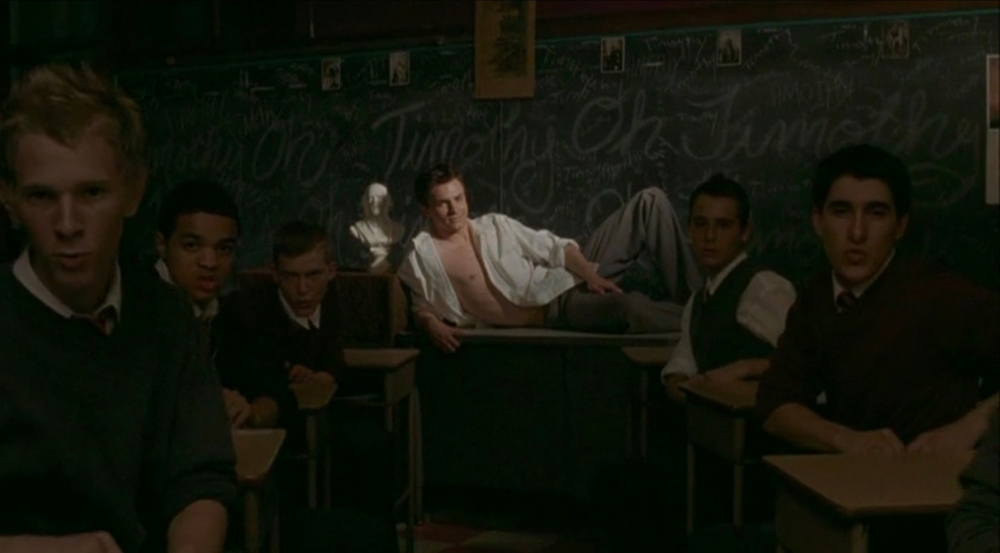
Emma Rice, in her inaugural production as Artistic Director of Shakespeare’s Globe in 2016, similarly re-envisions Helena’s unrequited desire for Demetrius as a queer love story by regendering the normally female lover into Helenus, a gay man. The production works well and is unapologetically queer, but because it adheres so closely to Shakespeare’s original text, only changing some pronouns and making other minor edits, the ultimate marriage between Helenus and Demetrius is tinged with questionable ethics: there is no indication that Demetrius is not still under the effects of the love potion, so is this enforced homosexuality—and should we celebrate that? Gustafson has no such constraints in his film. As an analogy, this problematic point can be quickly washed away with a line from Jonathon, after all the people who were once under the flower’s spell are returned to their natural states, who kisses Timothy and proclaims, “I feel like myself.” Because the film is not Shakespeare, but only inspired by Shakespeare, it has the freedom to clean up such ethical snags. In fact, its very status as an analogy has massive effects throughout its cinematic text on its claim to being a clear adaptation of Shakespeare. This is most evident in the famous “lovers’ quarrel” (3.2 in Midsummer) that necessarily expands to include not just the four main lovers of the film, but also others caught up in the plot, like Jonathon’s ex-girlfriend. Timothy thus takes on the analogue of Puck, the character he is playing in the school production, and also of Helena, the once-scorned and now multiply-adored lover. This framing imagines Shakespeare’s play as if Helena made the love potion—an interesting creative choice, but one that continues to deepen the remove from the Shakespearean source. Were the World Mine has several queer characters and explores issues relevant to queer audiences, but most of the film, outside of the school production and the love potion, is nearly unrecognizable as Shakespeare. The film utilizes Shakespeare, but does not necessarily adapt it, throwing its claim to being a fully successful queer Shakespeare adaptation into question.
Allen Brown’s Private Romeo, released in 2011, explores similar themes to Were the World Mine, but with a very specific milieu and an adherence to Shakespeare that sharpens its intended commentary. While the rest of the school goes on an off-campus excursion, eight cadets at the fictional McKinley Military Academy continue their study of Romeo and Juliet as, in a fantastical plotting device, the play consumes the imaginations of the young men involved. Unlike Were the World Mine, the dialogue of Private Romeo is mostly Shakespeare’s, and its plot closely follows Romeo and Juliet. The film’s framing device allows for a subversive superpositionality: as Romeo and Juliet fall in love, so too do their analogues Sam Singleton and Glenn Mangan. Even though Juliet would have been played by a male actor during Shakespeare’s time, he would have been dressed and performing the role as a woman. Playing two of the most famous heterosexual lovers in all of Anglophone culture as homosexual men is certainly a very queer act. Also, unlike Gustafson’s film, Sam/Romeo does not need any magic potion to embrace his queer sexuality, but instead refreshingly proclaims his love for Glenn/Juliet despite having previously been besotted with Rosaline in a presumably heterosexual manner. In what Patricia points to as the queerest moment in the film, the ending is even re-written so that Juliet’s kiss awakens Romeo (see Figures 7-8), providing queer audiences with a drastically (compared to most queer narratives) unexpected happy ending (84). Brown uses his film to decry “Don’t Ask, Don’t Tell” (DADT), a U.S. policy that protected closeted servicepeople from harassment, but also enforced them into remaining closeted. As Patricia puts it: in Private Romeo, “boy meets boy; boy and boy fall in love; boy and boy get married; boy and boy live happily ever after” (87). Homosexual love triumphs over anticipated death, implying that allowing same-sex relationships (and marriage) can subvert tragedy. The film was made just prior to DADT’s repeal so it did little to effect change; nevertheless, Brown is using Shakespeare to assert his objections to a policy that specifically affected members of the queer community.
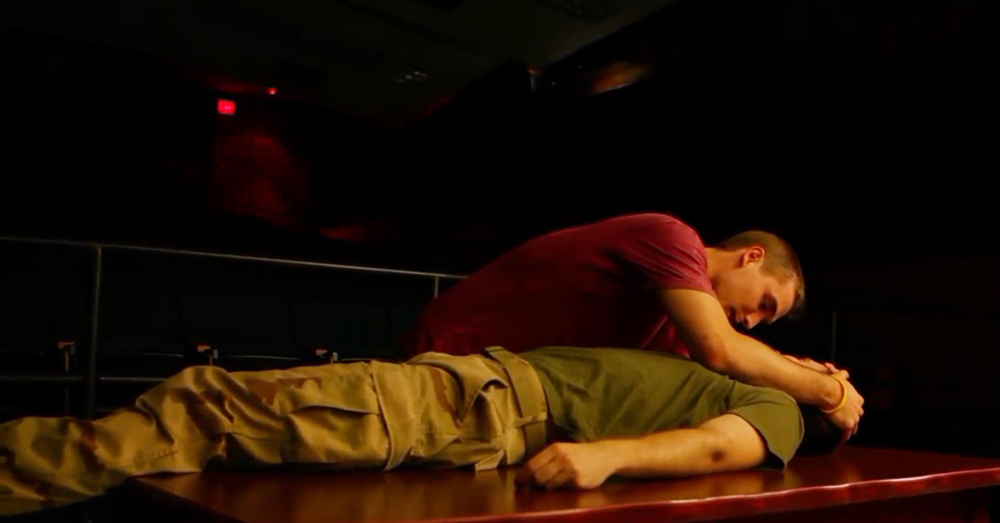
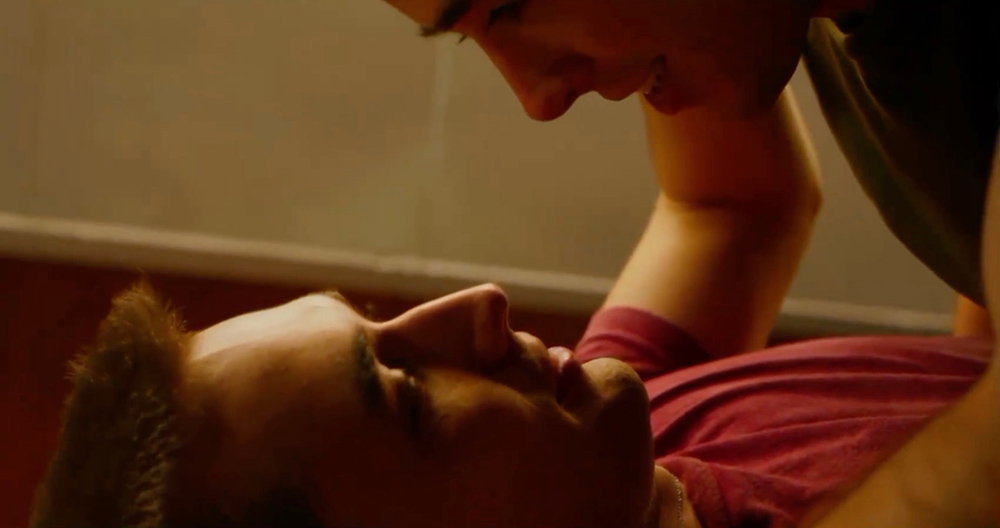
My biggest concern with the film is its confusion over gender, which is not explored fully enough. When Glenn is being addressed as Juliet, Shakespeare’s language remains unchanged—including feminine pronouns and terms like “lady”—which is at times used for derision (misgendering as a form of bullying) but also done by Sam/Romeo (presumably as a sign of affection or acceptance.) While Patricia analyzes this choice as queer (75-78), I find it both jarring and ambivalent toward the current and often contentious debates over pronouns within the queer community (see Hanna et al.). In the end, it is just one qualm, albeit quite a large one, in an otherwise commendable queer Shakespeare film. Of all the films explored in this study, Private Romeo stands apart in its success in indigenizing Shakespeare to queer culture, even if its queerness is sometimes ethically clunky and it remains a little-seen and less-explored text within the queer Shakespeare canon.
Apart from those two examples, most other Shakespeare films fail to be queer or, similarly to Were the World Mine, are queer but fail to really be Shakespeare. The most successful queer adaptation of early modern theatre onto film, according to our framework at least, is not, perhaps surprisingly given his pre-eminence within the genre, based on Shakespeare at all. Derek Jarman’s Edward II (1991) epitomizes the way a film can take an early modern play and make it relevant to a contemporary queer audience. Jarman, in his signature postmodernist style, uses Christopher Marlowe’s text, first published in 1594, to interrogate the persecution of gay men in the early 1990s. Jarman makes this explicit in his screenplay, aptly titled Queer Edward II, which is dedicated to “the repeal of all anti-gay laws, particularly Section 28” (Friedman 576).3 Jarman goes to great lengths to relate the fates of Edward, Gaveston, and Spencer (all purportedly homosexual, even in Marlowe’s play) to those of queer activists protesting for government action on the AIDS epidemic, leading to lethal confrontations with the police. Jarman also indigenizes the play for a gay audience, most obviously in the appearance of Annie Lennox singing “Ev’ry Time We Say Goodbye” written by the notably gay Cole Porter (see Figure 9)—echoing Jarman’s use of Welch singing another Porter song in his Tempest. Lennox, a “gay icon” of the period, was also a major advocate for the LGBT community and specifically aided in the fight against HIV/AIDS. All this contributes to Jarman’s film being a distinctly successful queer film adaptation, although decidedly not Shakespeare.
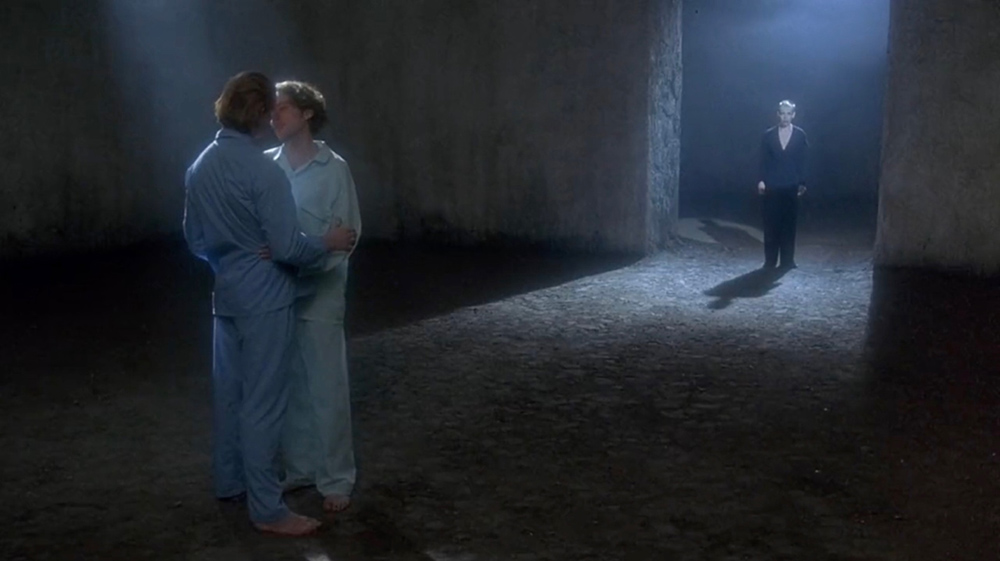
Looking to the Future (and the Past)
Given its anemic history, what is the future for queer film adaptations of Shakespeare? Films that use Shakespeare to denounce certain facets of homophobia, such as Were the World Mine or Private Romeo, may feel less relevant to queer American audiences after the institutionalization of same-sex marriage and the repeal of DADT. Were the World Mine’s commentary on homophobia feels somewhat staler than its engagement with the utilization of fantasy to deal with unrequited love for heterosexual love-objects. There are still plenty of aspects of queer culture, many of which Halperin meticulously details in his book on gay male culture specifically, which remain underexplored in queer cinema, to say nothing of the contemporary injustice and inequality that exist for queer people today. What is clear is that all the examples explored thus far deal specifically with gay, cisgendered (white) men; and there are very few exceptions to this trend in the larger queer Shakespeare film oeuvre. One could argue that the disparity of female characters in Shakespeare’s plays could explain the lack of lesbian adaptations, but, as they are adaptations, gender-bent casting is not only possible—see Helen Mirren in Julie Taymor’s The Tempest (2010)—but can provide queer possibilities, as illustrated by Private Romeo (see Patricia 75-81). The story of Romeo and Juliet has been adapted numerous times where the analogue for Juliet is recast as a man, but rarely, if ever, is Romeo recast as a woman.4 A lesbian adaptation of Romeo and Juliet (or any of Shakespeare’s canon) feels conspicuously overdue.
So too does more visibility for people who are transgender or genderqueer. As more trans stories are being told throughout American media, it is disappointing that Shakespeare’s plays—with all their themes of gender trouble—have not inspired any artists to transpose them into trans narratives. It is important to note that transness as a disguise is an incredibly harmful stereotype that has led to the rash of so-called “bathroom bills” in the United States. Still, there is space for using Shakespeare’s “breeches roles” to explore issues important to modern queer people, including gender nonconformity, dysphoria, drag, or even pansexuality. If She’s the Man (Fickman 2006) were made today, I doubt a cisgender actor like Amanda Bynes would be cast as the Viola/Cesario analogue, but instead someone who is trans or non-binary (to say nothing of its passé, even offensive, title.)
Considering the scarcity of trans Shakespeare adaptations, it may be surprising that I identified one significant exception from the early twentieth century: Asta Nielsen’s Hamlet: The Drama of Vengeance (Gade and Schall 1921). It does not adapt or appropriate any of Shakespeare’s comedies, which may ostensibly seem more primed for explorations of transness or trans culture, but instead adapts one of his greatest tragedies, unconventionally incorporating a trans narrative through its feminist raison d’être. Nielsen was a Danish actor who made seventy-six films between 1910-1932 that “made her one of the first, if not the first, and one of the greatest, if not the greatest, international screen stars of the 1910s and 1920s” (Allen 205). After forming her own film company in 1920, Nielsen began production on her first project, an adaptation of Hamlet. The transmediation of Shakespeare to silent film is already tricky (see Buchanan), and Nielsen, always the renegade, was not content to play Gertrude or Ophelia, instead unapologetically taking the title role. She was not the first woman to play Hamlet on film (Sarah Bernhardt was the first person, of any gender, to be filmed as Hamlet), but Nielsen took unexpected inspiration from an influential pseudo-academic book of the Victorian era: The Mystery of Hamlet by Edward Vining. In a flourish of misogyny, Vining goes to great lengths to argue that Shakespeare’s Dane could not possibly have been a man but must have really been a woman raised as a man to secure succession to the throne. Vining’s thesis may ring problematic today, but Nielsen took this idea and created one of the most daring and unprecedented of all the queer Shakespeare films discussed so far.
Delilah Bermudez Brataas claims “Nielsen was able to employ Vining’s premise to perform gender fluidity and to convey that fluidity as the means to achieve ambition and agency” (4). Nielsen’s film was made over a century ago, but the exploration of gender fluidity feels like a particularly contemporary interest considering the rise of alternative gender expressions (see Ennis). Whether or not Nielsen had access to the language we use to discuss trans issues today, her film does just that. Her Hamlet is raised as—and forced to conform to the gendered expectations of being—a man, even though the audience is “never allowed to forget that Hamlet not only is a woman but has the feelings and desires of a woman” (Allen 208). Although there is a surprising lack of any extended “To be or not to be” sequence—Hamlet holds a dagger to her wrist, but quickly concludes, “Too weak to kill — and too strong to die!”—just minutes later, another major dilemma is laid out in an intertitle as Nielsen grasps her breasts: “I am not man! [sic] — And must not be a woman! But you forget — I have a heart!” (see Figure 10). While Hamlet’s suicidal ideations are partially attributed here to her inability for vengeance (the traditional reading of Shakespeare’s text), her gender dysphoria also plays a role. Given the shockingly high rate of suicide within the trans community—“[d]ata indicate that 82% of transgender individuals have considered killing themselves and 40% have attempted suicide” (Austin et al. 2020)—this reinterpretation of Shakespeare has a deep relevance to queer audiences today.
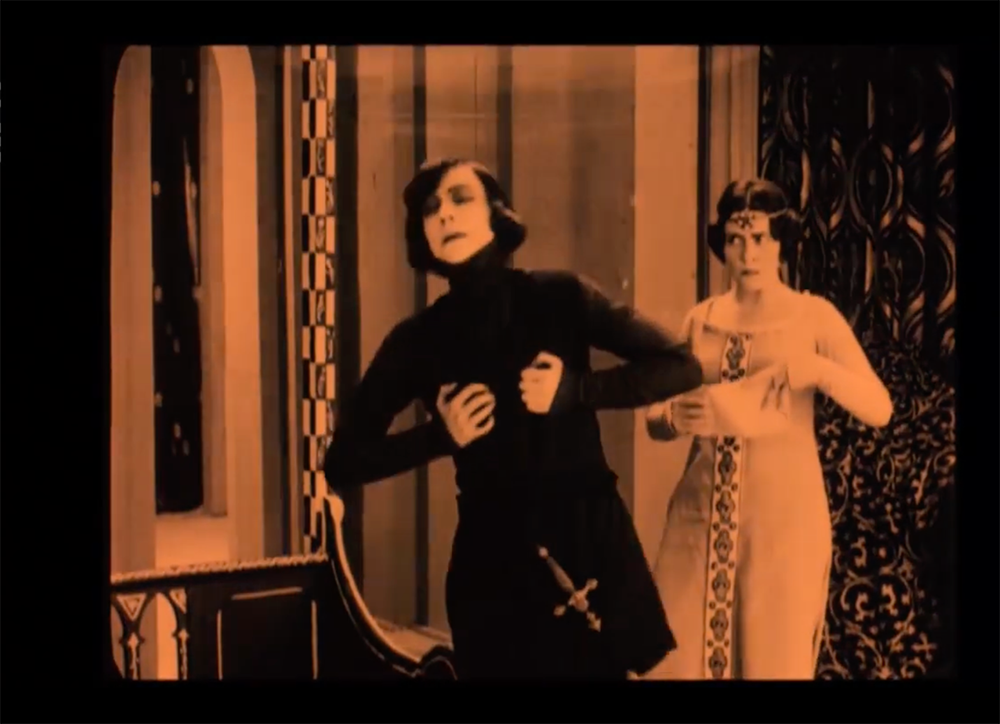
Of course, Nielsen did not set out to make a queer Shakespeare film; even if she had, the vocabulary to do so, both cinematically and theoretically, was not accessible to her. The necessity to go back a century to find a Shakespeare film that portrays a trans story bespeaks the lack of adaptations directed at a queer audience. Even Jarman’s successful (albeit non-Shakespearean) attempt at making a queer early modern film was over thirty years ago. While more recent low-budget (and little-watched) attempts like Private Romeo and Were the World Mine are commendable, both are flawed in unique and limiting ways and rarely cited in the larger conversation of film adaptations of Shakespeare. Only My Own Private Idaho, Loncraine’s Richard III, and Jarman’s The Tempest seem to fit into this discourse, all of which are deeply problematic or unrecognizable as queer adaptations according to our framework. It is disappointing to conclude that, with the exception perhaps of Private Romeo, no recent work can claim the title of a fully successful queer Shakespeare film. This is a call, then, for filmmakers to fill that gap, to localize Shakespeare within the queer world, and to make a successful queer Shakespeare film for the twenty-first century.
Endnotes
1 For an extended discourse on this, see Patricia’s chapter focused on the film in Queering the Shakespeare Film (41-88).
2 See Stephen M. Buhler’s analysis of the film, in particular 51-55, for more on this argument.
3 Section 28 of the Local Government Act 1988, effective in England until 2003, prohibited “promotion” of homosexuality by local authorities or schools (Lee 675). This has renewed relevance in the wake of the passage of Florida’s “Don’t Say Gay” law, which has similar aims to Section 28 (Phillips).
4 The Bubble (Fox 2006), Private Romeo (Brown 2011), TV series Romeu & Romeu (2016), and Joe Calarco’s play Shakespeare’s R&J (an inspiration for Brown’s Private Romeo), all feature male Juliet analogues, to name just a few.
Works Cited
10 Things I Hate About You. Directed by Gil Junger, Buena Vista Pictures, 1999.
Allen, Robert C. “Asta Nielsen: The Silent Muse.” Sight and Sound, Fall 1973, pp. 205-209.
Austin, Ashley, et al. “Suicidality Among Transgender Youth: Elucidating the Role of Interpersonal Risk Factors.” Journal of Interpersonal Violence, 29 Apr. 2020.
Benshoff, Harry M. and Sean Griffin. Queer Images: A History of Gay and Lesbian Film in America. Rowman & Littlefield Publishers, Inc., 2006.
Brataas, Delilah Bermudez. “The Shadow’s Shadow, or Gendered Ambition in Asta Nielsen’s 1921 Hamlet.” Cahiers Élisabéthains, vol. 98, 2019, pp. 3-21.
The Bubble. Directed by Eytan Fox, United King Films, 2006.
Buchanan, Judith. Shakespeare on Silent Film: An Excellent Dumb Discourse. Cambridge University Press, 2009.
Buhler, Stephen M. “Camp Richard III and the Burdens of (Stage/Film) History.” Shakespeare, Film, Fin de Siècle, edited by Mark Thornton Burnett and Ramona Wray, Macmillan Press, 2000, pp. 40-57.
Calarco, Joe. Shakespeare’s R&J. Methuen Drama, 2003.
Chedgzoy, Kate. Shakespeare’s Queer Children: Sexual Politics and Contemporary Culture. Manchester UP, 1995.
Cheshire, Godfrey. “High Styles: My Own Private Idaho (Gus Van Sant) and The Rapture (Michael Tolkin).” The Press Gang: Writings on Cinema from New York Press, 1991-2011, edited by Jim Colvill, e-book, Seven Stories Press, 2020.
Chiba, Jessica. “Lost and Found in Translation: Hybridity in Kurosawa’s Ran.” Shakespeare Bulletin, vol. 36, no. 4, Winter 2018, pp. 599-633.
Cymbeline. Directed by Michael Almereyda, Lionsgate, 2014.
Dionne, Craig and Parmita Kapadia. Introduction. Native Shakespeares: Indigenous Appropriations on a Global Stage, edited by Dionne and Kapadia, Ashgate, 2008, pp. 1-15.
Edward II. Directed by Derek Jarman, Palace Pictures, 1991.
Ennis, Dawn. “New Research Reveals Insights Into America’s Nonbinary Youth.” Forbes, 13 July 2021, www.forbes.com/sites/dawnstaceyennis/2021/07/13/new-research-reveals-insights-into-americas-nonbinary-youth/?sh=2997773a18eb.
Fernández, José Ramón Díaz. “Shakespeare on screen in the digital era: an annotated bibliography.” Cahiers Élisabéthains, vol. 105, 2021, pp. 128-169.
Friedman, Michael D. “Horror, Homosexuality, and Homiciphilia in McKellen’s Richard III and Jarman’s Edward II.” Shakespeare Bulletin, vol. 27, no. 4, Winter 2009, pp. 567-588.
Harris, Diana and MacDonald Jackson. “Stormy Weather: Derek Jarman’s The Tempest.” Literature/Film Quarterly, vol. 25, no. 2, 1997, pp. 90-98.
Hamlet. Directed by Celestino Coronado, Essential Productions and Royal College of Art, 1976.
Hamlet: The Drama of Vengeance. Directed by Svend Gade and Heinz Schall, performances by Asta Nielsen, et al., Asta Films, 1921.
Halperin, David M. How to Be Gay. Harvard UP, 2012.
Howard, Tony. Women as Hamlet: Performance and Interpretation in Theatre, Film and Fiction. Cambridge UP, 2007.
Jeffreys, Joe E. “RuPaul’s Drag Race and What People Get Wrong About the History of Drag.” Interview by Wilder Davies. Time, 9 Mar. 2018. time.com/5188791/rupauls-drag-race-history/.
Lee, Catherine. “Fifteen years on: the legacy of section 28 for LGBT+ teachers in English schools.” Sex Education, vol. 19, no. 6, 2019, pp. 675-690.
Madhavi, Menon. ShakesQueer: A Queer Companion to the Complete Works of William Shakespeare. Duke UP, 2011.
Macbeth. Directed by Geoffrey Wright, Palace Films and Cinemas, 2006.
Maqbool. Directed by Vishal Bhardwaj, Kaleidoscope Entertainment and Yash Raj Films, 2004.
McFarlane, Brian. Novel to Film: An Introduction to the Theory of Adaptation. Oxford UP, 1996.
A Midsummer Night’s Dream. Directed by Emma Rice, written by William Shakespeare, Shakespeare’s Globe, 2016, Globe Theatre, London.
My Own Private Idaho. Directed by Gus Van Sant, Fine Line Features, 1991.
Patricia, Anthony Guy. Queering the Shakespeare Film. Bloomsbury Arden Shakespeare, 2017.
Phillips, Amber. “Florida’s law limiting LGBTQ discussion in schools, explained.” The Washington Post, 1 Apr. 2022, www.washingtonpost.com/politics/2022/04/01/ what-is-florida-dont-say-gay-bill/.
Private Romeo. Directed by Alan Brown, Wolfe Releasing, 2011.
Ran. Directed by Akira Kurosawa, Toho, 1985.
Richard III. Directed by Richard Loncraine, Guild Film Distribution, 1995.
Renes, Cornelis Martin. “Tempted by The Tempest: Derek Jarman’s Gay Play with Shakespearean Romance.” Proceedings 31st AEDEAN Conference, edited by M.J. Lorenzo Modia, A Coruña: Universidadede, 2008, pp. 225-233.
Romeo and Juliet. Directed by Franco Zeffirelli, Paramount Pictures, 1968.
Romeu & Romeu. Created by Arthur Chermont and Faell Vasconcelos, Mistura de Artes and Substrato Films, 2016.
Russo, Vito. The Celluloid Closet: Homosexuality in the Movies. 1981. 2nd ed., Harper & Row, 1987.
Sanders, Julie. Adaptation and Appropriation. 2nd ed., Routledge, 2016.
Seidl, Monika. “Room for Asta: Gender Roles and Melodrama in Asta Nielsen’s Filmic Version of Hamlet (1920).” Literature/Film Quarterly, vol. 30, no. 3, 2002, pp. 208-216.
Semenza, Greg Colón. “Introduction.” Shakespeare Studies, vol. 38, 2010, pp. 19-25.
Senelick, Laurence. “Boys and Girls Together: Subcultural origins of glamour drag and male impersonation on the nineteenth-century stage.” Crossing the Stage: Controversies on cross-dressing, edited by Lesley Ferris, Routledge, 1993.
“ShakesQueer.” RuPaul’s Drag Race, season 7, episode 3, Logo, 16 Mar. 2015. WOW Presents Plus, www.wowpresentsplus.com/rupaul-s-drag-race-2/season:7/videos/703-wow-tv-ready.
She’s the Man. Directed by Andy Fickman, Paramount Pictures, 2006.
Sinfield, Alan. Shakespeare, Authority, Sexuality: Unfinished Business in Cultural Materialism. Routledge, 2006.
The Tempest. Directed by Derek Jarman, Kino International, 1973.
The Tempest. Directed by Julie Taymor, Walt Disney Studios Motion Pictures, 2010.
Van Watson, William. “Shakespeare, Zeffirelli, and the Homosexual Gaze.” Literature/Film Quarterly, vol. 20, no. 4, 1992, pp. 308-25.
Vining, Edward P. The Mystery of Hamlet: An Attempt to Solve an Old Problem. Philadelphia: J.B. Lippincott & Co., 1881.
Wagner, Geoffrey. The Novel and the Cinema. Rutherford, NJ: Fairleigh Dickinson UP, 1975.
Were the World Mine. Directed by Tom Gustafson, SPEAKproductions, 2008.
West Side Story. Directed by Robert Wise and Jerome Robbins, United Artists, 1961.